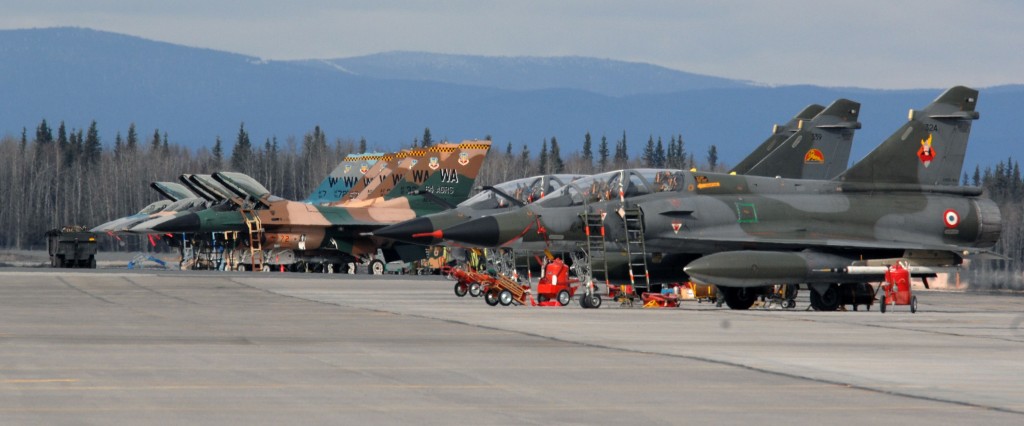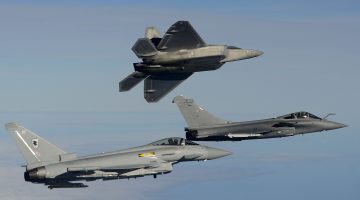(Source: Breaking Defense) By Murielle Delaporte – Coalition operations are becoming a norm for democracies. Effective coalition operations are built on solid military planning, exercises, and training, as well as on shared experiences. A key example of such collaborative efforts is the Trilateral Strategic Initiative, established in October 2010 by the Air Force chiefs of staff of the US, France and the UK, then Gens. Norton Schwartz, Jean-Paul Palomeros and Air Chief Marshal Sir Stephen Dalton.
Col. Cyril Carcy, the only French Air Force officer currently embedded with U.S. Air Force’s Strategic Studies Group as a result of this enhanced cooperation among the three countries, describes the three pillars of the TSI this way: “Mutual trust among upcoming Air Force decision-makers, which is essential to prepare the future; integration of the three Air Forces, which goes beyond interoperability; air power advocacy, which means that air chiefs may speak with a coherent and unified voice.” Trust, integration and advocacy are the credo guiding the USAF, the FAF and the RAF on the road to enhanced military cooperation and integration among themselves, but also within and beyond NATO.
Trust: “In The Winds of History”
“When I was a Jaguar pilot in 1995, not a single month would go by without a combined mission with my British or American counterparts,” recalls Col. Carcy. “Our respective air forces always worked together very spontaneously whether in Bosnia, Kosovo, Afghanistan, and more recently in Libya and Mali.” And those ties have grown closer. After France rejoined NATO’s integrated military command in 2009 and France and the UK signed the Lancaster House Treaty in 2010, this trilateral relationship has intensified, building on core attributes shared by the three NATO air powers:
All three states are nuclear powers and permanent members of the UN Security Council, each with political processes which enable prompt military intervention when necessary.
Strategically, they share a congruent analysis and vision of world threats and risks (international terrorism; cybersecurity; global commons; etc).
Militarily, they have in common a wide array of capabilities including expeditionary forces and Command and Control (C2) structures.
The build-up of trust has not been achieved overnight and is underpinned by a long tradition of a significant number of exchange officers. As far as Franco-American exchanges are concerned, about 10 different units, from academics to operational squadrons on each side of the Atlantic are involved. These include a French aerospace teacher assigned to the U.S. Air Force Academy, French and US pilots flying A-10s and Mirage 2000 fighters respectively, CSAR helicopters Sikorsky MH-60G Blackhawk and Eurocopter EC 725 Caracal, and even C-130s. This emphasis on officer exchanges is true at both the US-UK and at Anglo-French levels: “Since the summer 2012, a British pilot has been flying Rafales, and a French pilot flying Typhoons. In Afghanistan the exchange was between Mirage 2000 and Tornado. In my case,” the colonel said, “at the strategic level, I work side by side with my British counterpart for the Chief of the Air Staff, while the same logic applies in London and Paris, involving a total of nine officers dedicated to assist the three Chiefs in their efforts to reinforce air power integration.”
Integration: Optimizing C2
In addition to the establishment of a long-lasting network of interconnected officers, the TSI has been very active over the past two years organizing workshops in each country, four so far this year and one is planned for the beginning of next year. “These workshops are aimed at helping us to better know each other and at increasing mutual trust, as well as our ability to work collectively. The goal is not to create interoperability, since we already have achieved that, but rather to bring this level of interoperability up to a higher and more effective level of integration. Indeed, a workshop dedicated to C2 processes, targeting and information sharing was held last December in Lyon and gathered about 40 specialists,” explains the French officer. This focus on command and control coherency as “the most important near-term priority” was set as a result of lessons identified during the Libyan operations as early as July 2012 and was shared with allies in a joint letter from the three Air Chiefs to the NATO SACT (Supreme Allied Commander Transformation). (…)
READ FULL ARTICLE >>> http://breakingdefense.com/2013/11/the-trilateral-strategic-initiative-an-allied-air-force-model/
Photo © Red Flag exercise, as published in ibid










